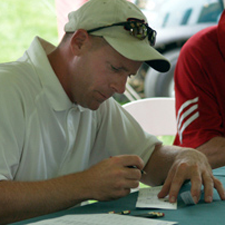The CHSAA State Boys’ HIgh School Championships (October 1-2) electrify the fall golf season in Colorado. Some of the best young golfers in the state survived one of 11 regional qualifying tournaments to earn an invitation to compete for an individual 3A, 4A or 5A state high school title. If three or four players from the same school qualify, they are also playing to earn their school a team state title as well.
These regionals are a very exciting and stressful time for teams, coaches and parents. Every player wants the opportunity to play ifor a state title, and for some it will be the biggest golf championship they ever play in.There is a lot of pressure on these kids, both during and after the round, and one player at regional qualifying learned a difficult lesson about a player’s responsibilites in the scoring area after the round. Imagine the surprise when the score posted on the scoreboard was 30 strokes higher than he shot.
Just like all stroke play championships, it is the player’s responsibility to assure that the score he turns in has 18 individual hole scores (i.e., a score in each box for the 18 holes on the course) and two signatures–one from his marker (the person assigned to keep his score) and his own signature. Although many do it anyway, it is NOT the responsibility of the player to add up the hole-by-hole scores and write down any totals (front 9, back 9 and 18). That is the responsibility of the committee.
In this case, the player went into the scoring area after he completed his round with his marker to review all of the scores. After he handed in his card and left the scoring area it was discovered that instead of a bogey 5 having been recorded in the box for the 18th hole, a 35 was written there instead. 35 was the number that his back nine total would have been having made a 5 on hole 18.
According to the Rules of Golf, Rule 6-6b states “After completion of the round, the competitor should check his score for each hole and settle any doubtful points with the Committee.” Rule 6-6c goes on to say that “no alteration may be made on a score card after the competitor has returned it to the committee.” And finally, Rule 6-6d says that “the competitor is responsible for the correctness of the score recorded for each hole on his score card. If he returns a score for any hole lower than actually taken, he is disqualified. If he returns a score for any hole higher than actually taken, the score as returned stands.”
The purpose of this Rule is to put the responsibility on the player to make sure he is informing the committee of his score, and he must do this in a timely manner. He needs to confirm that his marker has written down all of his hole-by-hole scores and verify that they are accurate before the player leaves the scoring area. In this area is where any Rules disputes should be resolved, once the player leaves the scoring area after he has handed his card to the committee, it is considered returned and he is responsible for anything written or not written on it.
In this situation the player was not disqualified because he did not sign for a score lower than he had actually taken, but instead had to take the 35 that was written down for the 18th hole, thus increasing his score by 30 strokes. Unfortunately, this kept him from playing in the state championships this year, but I am sure he will never leave the scoring area until he has verified every hole-by-hole score, and he’ll leave the math to the committee.


